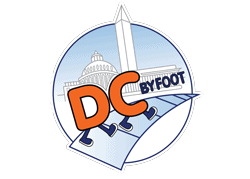This post covers how to use the Metro subway in Washington, D.C., including tips on SmartTrip Cards, tourist passes, and how to navigate the public transport system.
While the DC Metro is great for getting you around the city, it can't get you around the National Mall. Let DC by Foot be your guide on one of our pay-what-you-like tours.
- Paying for Trips
- DC Metro Rail Map, Lines, and Stations
- How to Ride the DC Metro
- Other Travel Options
- Tips from Locals and Travelers
- Things to Do in DC
- Tourist Passes
PAYING FOR TRIPS
There are a few ways you can pay for your trips on the metro.
The information below will tell you about each.
SmarTrip Cards
You will need a SmarTrip card to enter and exit the DC Metro system.
A SmarTrip card is required for each rider aged 5 and older. Cards cannot be shared so each rider needs their own.
Note that up to two children under age five may travel free with each fare-paying adult.
SmarTrip cards with fare loaded on them can be used on the:
- DC Metro
- DC Circulator bus
- ART (Arlington) bus
- CUE (Fairfax) bus
- DASH (Alexandria) bus
- Fairfax Connector bus
- RideOn (Montgomery County) bus
SmartTrip cards can be ordered online or you may buy a card at the station. They cost $15 each, with the price covering $2 for the card itself and a preloaded $13 credit.
They can be purchased from SmartTrip card vending machines like the one below, found at every Metro station.
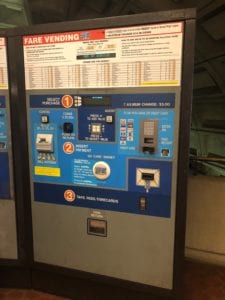
If you don't want to carry around a physical card, you can instead add a virtual card to your phone/mobile device using Apple Wallet or Google Pay.
There are also apps you can download onto your phone to do a number of things including purchasing cards, checking for trains, looking at maps, etc.
We recommend DCMetro Transit and MetroHero, however all of the apps over the same services. You only need too download one.
Pay-As-You-Go On The Metro
Another way to travel is by paying as you go.
There is no set fare for all trips as fares between stations depend on distance, the day, and the time.
Fares are based on the distance you'll be traveling between stations.
Each vending machine will show you what it costs to go from one station to another station in the system.
As far as times go, although the system does not have peak and off-peak hours, it does charge less at certain times.
From 5:00 am until 9:30 pm on weekdays the cost will land somewhere between $2 and $6.
After 9:30 pm on weekdays and over weekends, there will be a flat rate of $2.
Important Note: You can only use the same debit/card three times in one day before the machines will stop taking it. Metro machines do accept bills and coins though so you can always top things up that way.
1-Day and 3-Day Passes
If you don't want to worry about loading your card throughout the day, you can purchase a 1-day pass for $13/person or a 3-day pass for $28/person.
There are no travel restrictions, which means that you could use this pass anytime and without any additional charges.
While this may seem like a great deal, you'll want to do the math on how much you'll be traveling. The farther out your hotel or accommodations are, the better off this deal will be.
Passes will only work on Metrorail and Metrobus travel - passes are not accepted on regional buses, including the popular DC Circulator.
For most people, a 1 or 3-day pass really only makes sense if you plan on making more than 2 longer distance round trips per day.
Keep in mind that all Metrorail trips are a flat $2 fare on Saturdays and Sundays, so if you are mostly using Metro on a weekend, a pass is usually not the best deal. You are better off paying as you go.
If you're moving to DC or going to be spending a while in DC, there are 7-day pass and monthly commuter pass options.
These packages are specifically tailored to you and will give you unlimited rides for a set price. To learn more, click here.
DC METRO RAIL MAP, LINES, AND STATIONS
Metro stations are dotted throughout the city some stations have multiple entrances/exits.
You can locate them easily by looking for the tall brown post with the large letter M at the top.
The name of the station will be written on the side and the color of the lines that service that station will be encircled at the top of the post.
The Metro Lines
There are six lines, each represented by a different color.
- Red: serves the northern part of the city. The main stations are Union Station, Metro Center, Chinatown, and Dupont Circle.
- Blue: runs west-east through the city and then south. The main stations are Capitol South, Smithsonian, McPherson Square (White House), Arlington National Cemetery, and National Airport.
- Silver: runs west-east through the city. You can take this line all the way to Dulles Airport.
- Orange: runs east-west through the city. The orange/silver/blue lines follow the same tracks inside downtown. You will only need to pay attention to which train you're on if you're leaving the central area of the city.
- Green: runs north-south. Take the Green line to get to Navy-Yard/Nats Park Baseball Stadium.
- Yellow: runs north-south. The yellow line shares a track with Green for most of downtown. Both lines visit L'Enfant Plaza but Yellow continues south into Virginia to the Pentagon, National Airport, and King Street for Old Town Alexandria.
Washington DC Metro Map
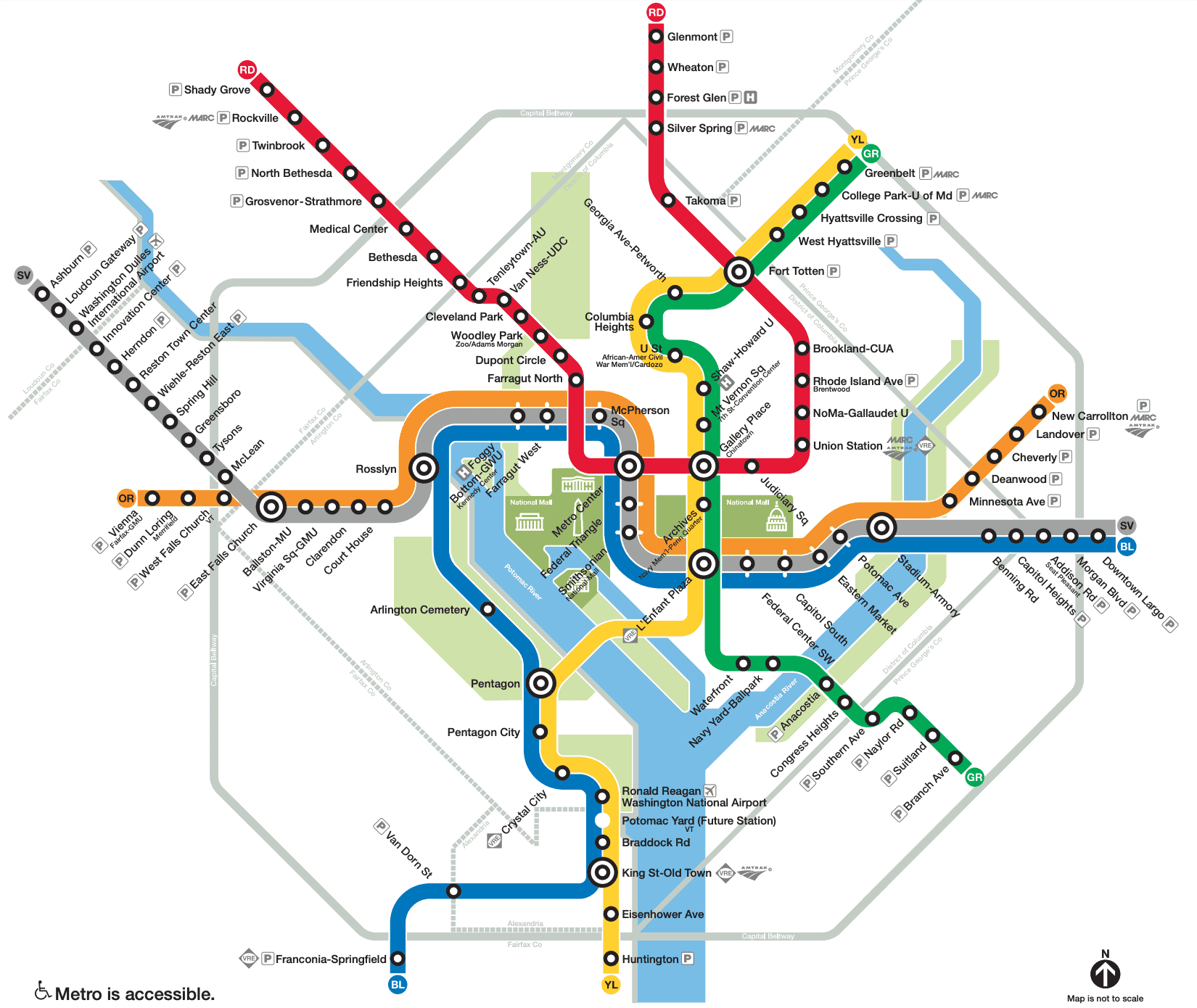
HOW TO RIDE THE DC METRO
The D.C. Metro system is a reliable and safe way to get around the nation's capital city.
Below is information that will help you plan and make your trip.
DC Metro Hours of Operation
In the table below, you'll find Metro's normal operating hours.
| DAY | TIME |
| Monday-Thursday | 5 am - 12 am |
| Friday | 5 am - 1 am |
| Saturday | 7 am - 1 am |
| Sunday | 7 am - 12 am |
Please note that the schedules can be different on holidays.
You can find a full Metro schedule here.
Savings With the SmarTrip Card
Metrobus charges $2 a trip no matter the time or distance, but if you use a SmarTrip card you'll save .20 cents a ride.
Also note that if you use SmarTrip card, there's a two-hour window in which you can make as many bus rides as you want without being charged again.
And if you use the SmartTrip during a transfer from a train to a bus (and vice versa), Metro will credit back to you the fare you paid entering the system.
How Much To Put On Your SmarTrip Card
Metro’s Trip Planner will help you find the best way between destinations.
You enter the address or location of each end of your trip. For example, you might want to enter "White House" and "Capitol Hill" as the two locations you'd like to travel between.
The system also allows you to enter advanced options such as the time, date, the distance you're willing to walk, and more.
It then provides you with a few itineraries to choose from. Each itinerary includes the length of the trip, walking and riding directions, and the cost of the trip.
Note that if you parked at a Metro parking lot, you can also use your SmartTrip card to pay for that. You may want to figure that into your calculations.
How To Use Your SmarTrip Card
If you're riding a bus, you'll tap your card on the bus farebox near the driver as you enter.
For a metro ride, look for a fare gate inside a station with a green light on it. Those are the gates that are in use.
They will have a circular target on top where you'll touch your SmarTrip card. This opens the gate and allows you to go further into the station.
Note that at the end of your trip, you also have to tap the fare gate on the way out of the station. Don't forget to tap out or it will charge you extra!
When exiting, if you take a look at the small digital display on the fare gate. It will tell you how much money you still have left on your card.
Getting To Your Platform
Depending on the station, you'll usually have to go to the lower level to get to the train platform.
If the platform is in the center, there will be an escalator in the center as well.
Once you are at the bottom, you can check the signs for which side of the platform you need to stand on to access your train.
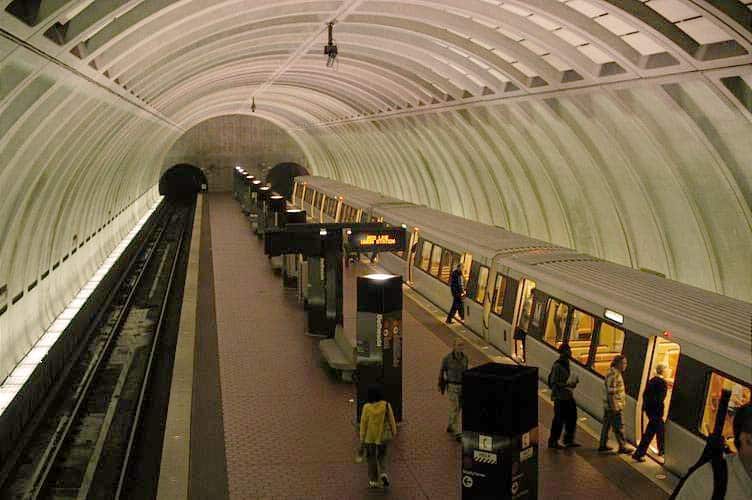
Center Platform
If the train tracks are in the center, and the platforms are on the sides, you'll need to take either or right or left escalator to get to that platform.
Again, check the signs to find which one you want to go down.
See below for more information on reading those signs correctly.
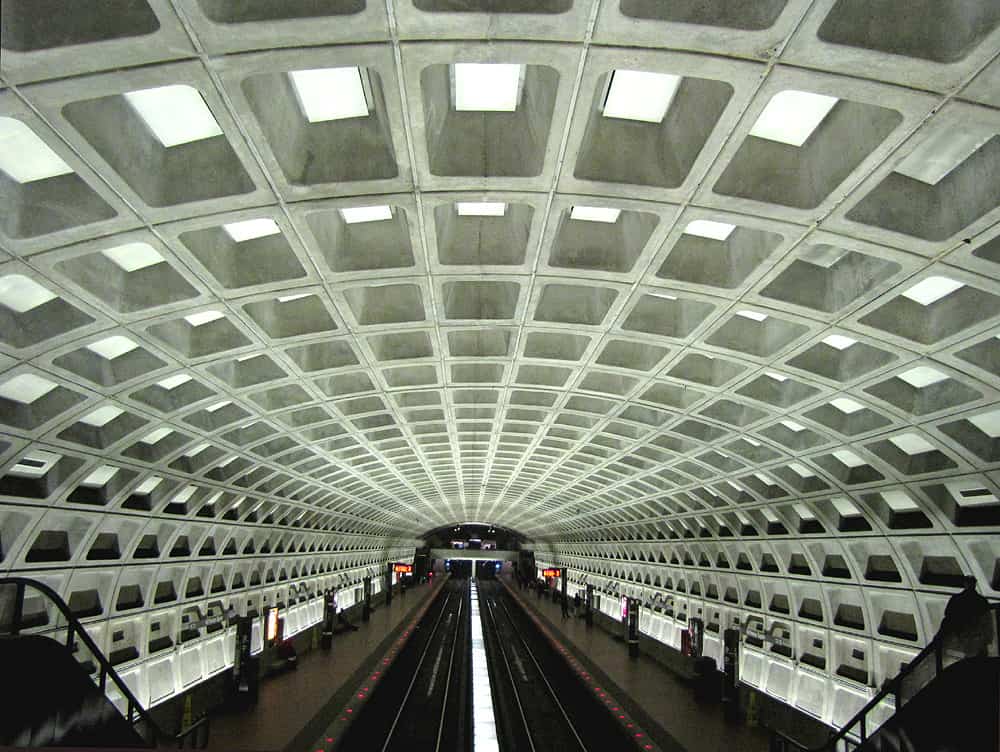
vs Center Tracks
Where to Stand To Catch the Correct Train
To decide which platform to stand on, you need to look for the name of the end-of-line.
There are maps in the stations to help you figure out the end of the line closest to your stop.
Then, find the platform that lists the corresponding final stop and head to it.
For stations with platforms on the sides, signs are usually listed at the top of the escalators so you know which side to go down to.
For stations with center platforms, you'll find signs at the bottom of the escalator.
Trains will also arrive with the end-of-the line station it's heading towards listed electronically on the front of it as well.
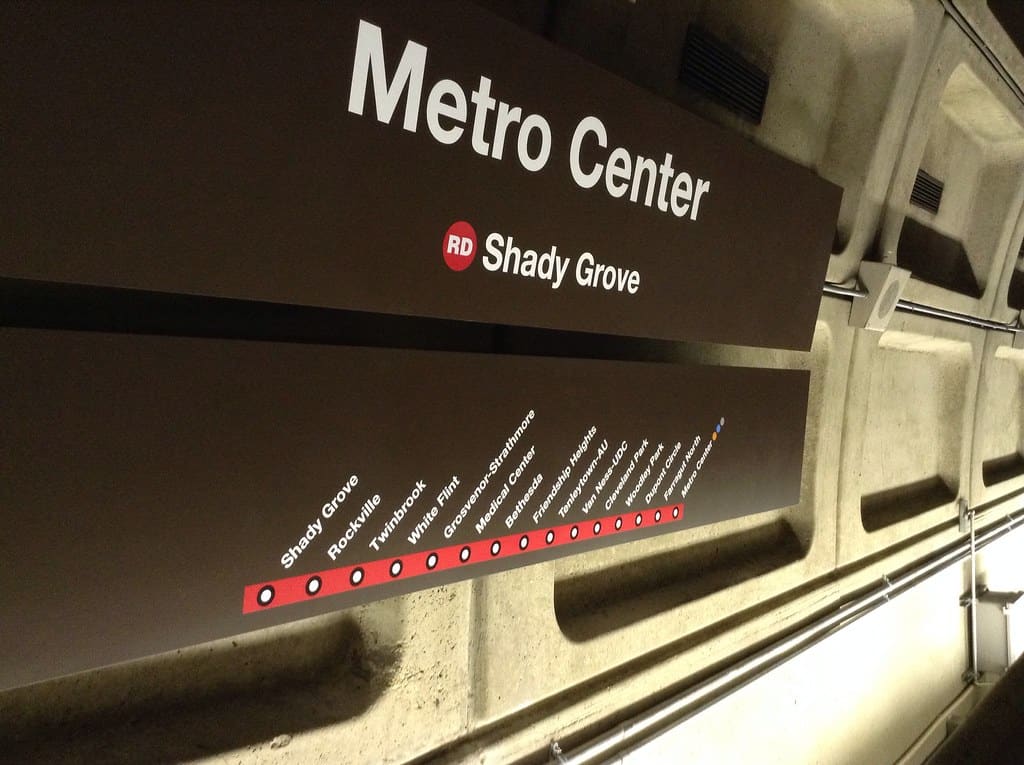
For example, as the picture above shows, the end-of-line for that half of the red line is Shady Grove.
You may want to get off at the Rockville stop, but you'll still need to know the name of last stop to ensure you're heading in the correct direction on that line.
If you were to get on the Red Line train to Glenmont instead of Shady Grove, you'd be going in the wrong direction and wouldn't find your stop along the way.
Trust us, it'll make sense once you're in the system!
Note: Sometimes trains don't go all the way to the end of the line but they will announce their last station stop.
As long as you're going in the right direction, and your stop is before that particular station, you'll be fine!
Reading the Signs On the Platform
When on the platform, signs will list the next three or four trains arriving.
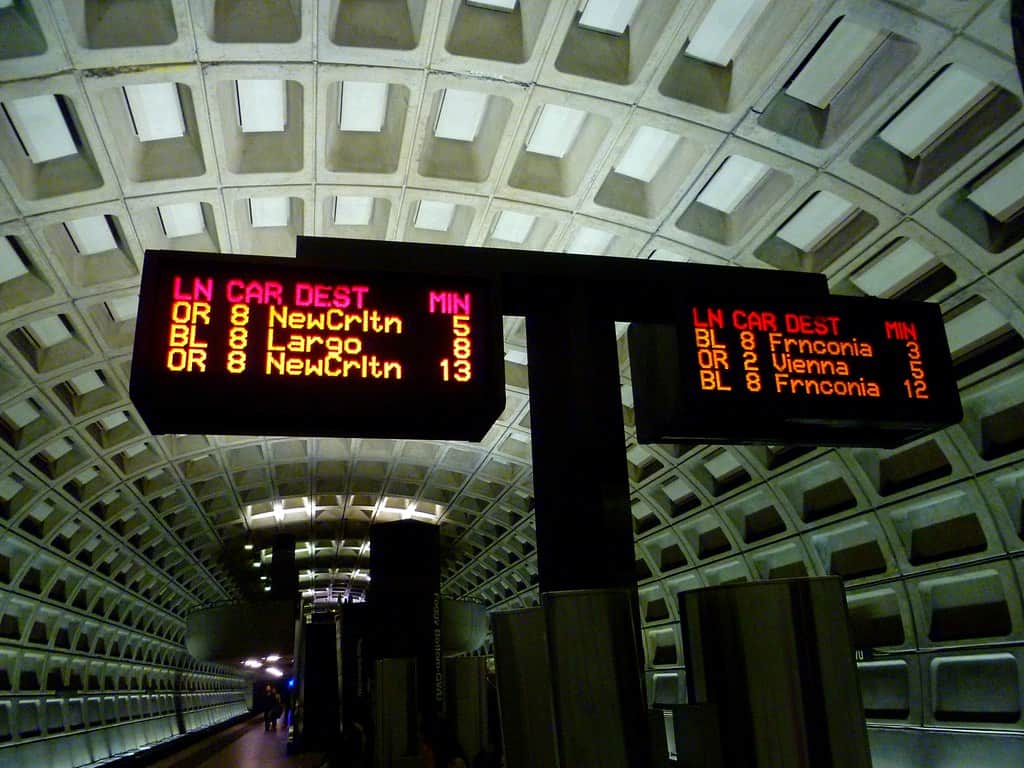
The information tells you four things:
- LN (Line) - which color line that train is on.
This matters if there are multiple colors of lines running through a station.
For example, Arlington National Cemetery is only on the Blue Line, but you may see Orange Line trains coming through on the same tracks. You'll want to be sure you are getting on a Blue Line train.
- CAR - how many cars are on that particular train.
If you stand at the very end of the platform, a shorter 6-car train may stop a distance from you. You'll then have to run to it to get on before the doors close.
Tip: If you check the platform's floor, there are sometimes decals to show you where those shorter 6-car trains end.
- DEST (Destination) - the last stop for this particular train.
Check this to make sure you're going in the right direction and on the correct line.
- MIN (Minutes) - how long until the train arrives.
During peak hours trains will come more frequently and in the evening they will come less often.
Keep this in mind if you're staying out late, as you might have to wait up to 20 minutes for the next train.
Getting on Your Train and Finding Your Stop
When a train is approaching, the circular lights at the edge of the platform will flash letting you know the train will be arriving soon.
Go up to the door and stand to the side. This lets people departing the train get off easily. Once they are off, you can more easily enter the train.
Once you are on the train, pay attention to the stops.
There are maps in each car and you'll be able to count out how many stops there are until you need to get off.
Note that some older trains won't electronically list the next stop in the route inside the car like the newer cars will.
And although train operators will announce stops it can sometimes be difficult to hear.
However, you can see which station you're arriving at as the train pulls in because the name of the station will be on the wall outside.
Getting to and From the Airport
DCA (Reagan National) and IAD (Dulles) airports are accessible by Metro though you may need to walk a bit to reach your terminal.
Our blogs posts below will tell you more about that.
While the BWI (Baltimore Washington) Airport is no longer accessible directly by metro, click here to see our blog post about getting to and from BWI.
If you're running late or worried about being stranded thanks to a Metro breakdown, don't fret. Trains are only one piece of the complex transit system of Washington, DC.
Buses serve even more territory than trains and they are cheap, clean (mainly), and frequent. Most are operated by Metro, though the Circulator routes are operated by the DC Department of Transportation.
With that said, your SmarTrip card works on all Metrobuses. Of course, you can always opt for ride-hailing services like Uber or Lyft or Cabs.
Hop On Hop Off Buses
The Metro is a great way to get around the city, but as visitors, it may not get you everywhere you need to go.
For example, in the entire 5 square miles of the National Mall, there is only one Metro Station. And there is no station on the Tidal Basin.
Hop-On-Hop-Off buses can come in handy in this case.

There are many bus companies and ticketing options. Read our post on choosing the best one for you.
They all have stops at the main sites around the city such as the Lincoln Memorial, WWII Memorial, Jefferson Memorial, and the US Capitol Building. These four sites are at least a 15-minute walk, if not more, from a Metro station.
Most Hop On Hop Off buses are included for free with the purchase of most tourist passes.
And don't forget our walking tours!
All of our tours start and end within walking distance of a Metro station. And our guides can make sure you know the best way to get to and from any place you want to see in the most direct route.
TIPS FROM LOCALS AND TRAVELERS
While we do our best to provide all the information you'll need to ride the DC Metro, sometimes you need answers to specific questions related to your personal experience.
Free Tours by Foot has a Washington, DC Travel Trips group on Facebook with over 55,000 members. It's a great place to post a question you'd like an answer to.
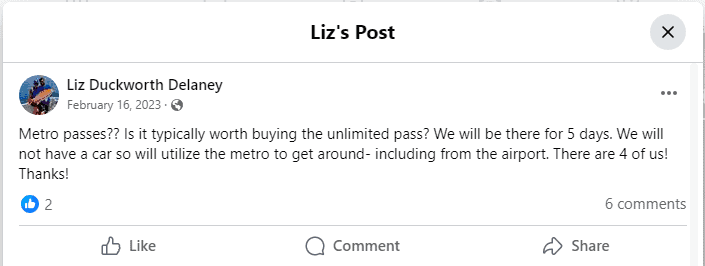

Here are a few other examples of interesting and helpful tips and tricks provided by staff and travelers, ones that will make things easier for you and your fellow riders.
- Don't stand on the left side of an escalator! The motto is: stand on the right, walk on the left. Some locals like to run up the steps of the escalator, so they are likely to be irritated (and vocal) if you're blocking the left side.
- Stand to the side of a bus or train door until everyone gets off. Standing smack in the middle of the door where people will get off the train is the quickest way to signal that you are a tourist. It's also a good way to get knocked around by all the bodies departing the train.
- Don't push your stroller through train doors to hold them open so you or others can get on. Doors have closed with children on one side and parents on the other. If the doors are closing, it's best to wait for the next train.
- If you have wheels, use the metro elevator. This means strollers, bikes, and wheelchairs. You may not want to wait for the elevator but trust us, the escalators are not made for anything with wheels. It's dangerous for all. Note also that all stations have elevators, though it's best to leave them for those who need them.
- Stand back from the side of the track. Yes, it's fun to see the train light coming through the darkness of a tunnel, and people are anxious about quickly getting on the train but it's dangerous to get too close. You could get jostled and fall onto the track, or your stroller could roll onto the trains due to the strong wind that comes through the station as the train arrives.
- Give up your seat to those who need them. If you see a pregnant person standing on the bus or metro...give her your seat. If you see someone leaning on crutches...give him your seat. If you see an octogenarian struggling against the forces of inertia and gravity...give up your seat!
- On the weekends, transferring to another Metro train isn't always the best option. Weekends are for track work, and that often means delays. Instead of transferring, see if there's a stop on the line you're already traveling on that's within striking distance of your destination. For example, if you're heading to the National Mall on the Red Line, skip the transfer over to the Blue/Orange/Silver lines by getting off at Metro Center. Sure, the Smithsonian Metro stop is smack in the middle of the Mall, but by the time you make the transfer, wait for a train, and then get back up to the surface, you could have already walked down from Metro Center.
- Check the time of the last train! If you're out late, be sure you remember to check when the trains stop running so you're not waiting on the platform for a train that won't come.
- Load before you go. If you're in town for a busy event, like the Fourth of July, a sporting event, or an inauguration, go ahead and load up the SmarTrip card with enough for the return trip as well. It'll save you from waiting in a massive line after the event.
RELEVANT POSTS
